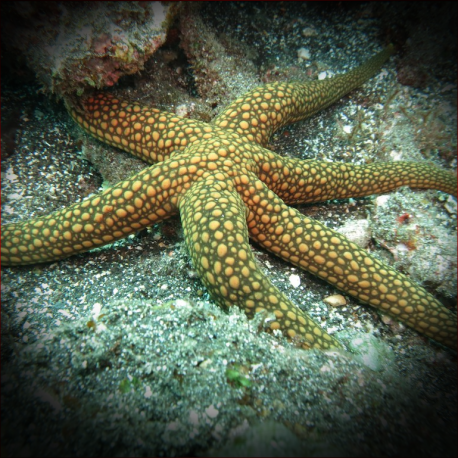More info
Datasheet
| Minimum Tank Size | 283 litres / 74.76 US gallons |
| Reef Compatible | Yes |
| Temperament | Peaceful |
| Care Description | Moderate |
| Specific Gravity | 1.023-1.025 |
| Carbonate Hardness | 8-12 |
| pH | 8.1-8.4 |
General Description
The Green Sea Star (Nardoa galatheae) is a member of the Ophidiasteridae family, characterized by its five-armed formation and greenish-brown color with a mottled appearance. In nature, it inhabits shallow rocky reefs and feeds on small microbes and detritus as it moves along the substrate.
Aquarium Suitability
Green Sea Stars are suitable for reef and fish-only aquariums, but caution is advised as larger specimens may consume small marine invertebrates. They require a sandy, coral rubble substrate with live rock containing algae, and a tank size of at least 283 litres to thrive.
Demands, Care, and Hardiness
Considered moderately demanding, Green Sea Stars are not tolerant of sudden changes in oxygen levels, salinity, and pH. They are sensitive to copper-based medications, necessitating the use of the drip acclimation method when introducing them to a new environment. Handling should be done carefully to avoid exposing them to air.
Reef Suitability
Green Sea Stars are deemed reef-compatible, provided the tank has the appropriate substrate and live rock setup to mimic their natural habitat. They contribute to the ecosystem by consuming detritus and small organisms.
Aquarium Setup
To create an optimal environment for Green Sea Stars, maintain water parameters within the range of pH 8.1-8.4, specific gravity of 1.023-1.025, and carbonate hardness (KH) of 8-12. Supplement their diet of small marine organisms and detritus with dried seaweed, algae pellets, and clam meat.
Behaviour
Green Sea Stars are known for their peaceful temperament within aquariums. They are primarily active scavengers, constantly foraging for food along the tank substrate and live rock.
Feeding and Diet
Being omnivores, Green Sea Stars feed on small microbes, detritus, and algae. In captivity, provide a varied diet that includes dried seaweed, algae pellets, and occasional morsels of clam meat to ensure balanced nutrition.
Dimorphism and Captive Reproduction
Green Sea Stars do not exhibit notable dimorphism in captivity. Reproduction in a home aquarium setting is rare and generally not observed due to the complexity of their reproductive process.
Habitat and Distribution
In their natural habitat, Green Sea Stars reside in shallow rocky reefs and coral rubble areas. They are commonly found in the marine environments of the Indo-Pacific region, where they play a vital role in the ecosystem as detritivores.

